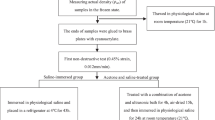Abstract
Bone allografts can be treated by various techniques before implantation. Recently, treatments based on supercritical carbon dioxide (CO2) were developed. The goal of this study was to evaluate the influence of such a treatment on the biomechanical properties of bone allografts. Thirteen human femoral heads obtained from patients who had undergone hip arthroplasty were cut along the frontal plane yielding to two slices with similar mechanical properties. For each femoral head, one of the two slices (randomly chosen) was fresh-frozen, whereas the other one underwent all steps of a supercritical CO2 based treatment in order to clean and secure bone tissue. Nine specimens (7 mm×9 mm×10 mm) per slice were then cut and loaded under compression in a physiologic saline solution maintained at 37°C. For the maximal compressive strength a mean value (SD) of 9.6 (2.4) MPa for fresh bone and 10.2 (5.2) MPa for treated one was found. Regarding the Young’s modulus a mean value of 417 (85) MPa was obtained for fresh specimens and 412 (149) MPa for the treated ones. No statistical difference was found between the bone specimens treated with supercritical CO2 and the fresh-frozen paired specimens when considering maximal compressive strength, Young’s modulus and work to failure.
Résumé
Les allogreffes osseuses peuvent être traitées par différents procédés avant implantation. Récemment le dioxyde de carbone (CO2) supercritique a été utilisé comme base d’un traitement. Le but de cette étude était d’évaluer l‘influence d’un tel procédé sur les propriétés biomécaniques d’allogreffes osseuses. Treize têtes fémorales, provenant de patients ayant eu une arthroplastie totale de hanche, ont été découpées selon le plan frontal en deux tranches ayant des propriétés mécaniques similaires. Pour chaque tête fémorale, une des deux tranches (de façon aléatoire) était congelée fraîche, alors que l’autre subissait les différentes étapes du traitement utilisant le CO2 supercritique. Neuf échantillons (7 mm×9 mm×10 mm) par tranche ont été découpés puis sollicités en compression dans un bain de sérum physiologique maintenu à 37°C. Pour la contrainte maximale en compression, la moyenne (écart type) est de 9.6 (2.4) MPa pour l’os frais et de 10.2 (5.2) MPa pour l’os traité. Quant au module d’Young les valeurs sont de 417 (85) MPa pour les échantillons frais et de 412 (149) MPa pour les échantillons traités. Aucune différence statistique, n’a été trouvée pour des échantillons traités par CO2supercritique par rapport à des échantillons appariés, frais et congelés, lorsque l’on considère la contrainte maximale à la rupture, le module d’élasticité et l‘énergie emmagasinée à la rupture.



Similar content being viewed by others
References
Birnbaum K, Sindelar R, Gartner JR, Wirtz DC (2001) Material properties of trabecular bone structures. Surg Radiol Anat 23(6):399–407
Brown TD, Ferguson AB Jr (1980) Mechanical property distributions in the cancellous bone of the human proximal femur. Acta Orthop Scand 51(3):429–437
Carter DR, Hayes WC (1977) The compressive behavior of bone as a two-phase porous structure. J Bone Joint Surg Am 59(7):954–962
Conrad EU, Ericksen DP, Tencer AF, Strong DM, Mackenzie AP (1993) The effects of freeze-drying and rehydration on cancellous bone. Clin Orthop 290:279–284
Cornu O, Banse X, Docquier PL, Luyckx S, Delloye C (2000) Effect of freeze-drying and gamma irradiation on the mechanical properties of human cancellous bone. J Orthop Res 18(3):426–431
Fages J, Marty A, Delga C, Condoret JS, Combes D, Frayssinet P (1994) Use of supercritical CO2 for bone delipidation. Biomaterials 15(9):650–656
Fages J, Poirier B, Barbier Y, Frayssinet P, Joffret ML, Majewski W, Bonel G, Larzul D (1998) Viral inactivation of human bone tissue using supercritical fluid extraction. Asaio J 44(4):289–293
Frayssinet P, Rouquet N, Mathon D, Autefage A, Fages J (1998) Histological integration of allogeneic cancellous bone tissue treated by supercritical CO2 implanted in sheep bones. Biomaterials 19(24):2247–2253
Hofmann AA, Hammon DJ, Daniels AU (1991) Compressive strength mapping of femoral head trabecular bone. J Rehabil Res Dev 28(2):25–32
Linde F, Gothgen CB, Hvid I, Pongsoipetch B (1988) Mechanical properties of trabecular bone by a non-destructive compression testing approach. Eng Med 17(1):23–29
Linde F, Sorensen HC (1993) The effect of different storage methods on the mechanical properties of trabecular bone. J Biomech 26(10):1249–1252
Martens M, Van Audekercke R, Delport P, De Meester P, Mulier JC (1983) The mechanical characteristics of cancellous bone at the upper femoral region. J Biomech 16(12):971–983
Mitton D, Rumelhart C, Hans D, Meunier PJ (1997) The effects of density and test conditions on measured compression and shear strength of cancellous bone from the lumbar vertebrae of ewes. Med Eng Phys 19(5):464–474
Schoenfeld CM, Lautenschlager EP, Meyer PR Jr (1974) Mechanical properties of human cancellous bone in the femoral head. Med Biol Eng 12(3):313–317
Thoren K, Aspenberg P, Thorngren KG (1995) Lipid extracted bank bone. Bone conductive and mechanical properties. Clin Orthop 311:232–246
Vastel L, Meunier A, Siney H, Sedel L, Courpied JP (2004) Effect of different sterilization processing methods on the mechanical properties of human cancellous bone allografts. Biomaterials 25(11):2105–2110
Acknowledgements
The authors are deeply grateful to I. Kojadinovic for his help in the data analysis. This study was partly funded by Biobank Company.
Author information
Authors and Affiliations
Corresponding author
Rights and permissions
About this article
Cite this article
Mitton, D., Rappeneau, J. & Bardonnet, R. Effect of a supercritical CO2 based treatment on mechanical properties of human cancellous bone. Eur J Orthop Surg Traumatol 15, 264–269 (2005). https://doi.org/10.1007/s00590-005-0250-x
Received:
Accepted:
Published:
Issue Date:
DOI: https://doi.org/10.1007/s00590-005-0250-x




